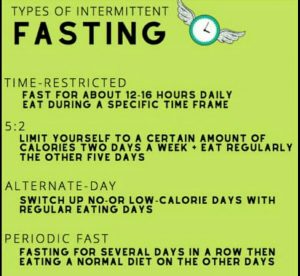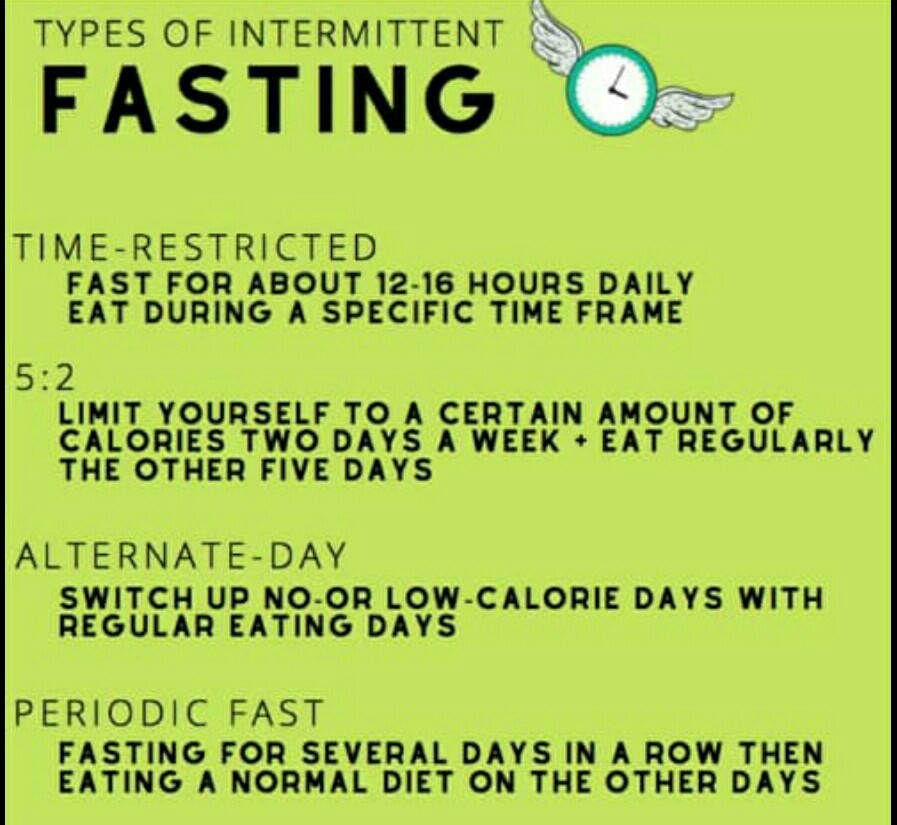Intermittent Fasting Types and Benefits of Each…This article is about the types of intermittent fasting and the benefits of each.
Welcome to www.nimedhealth.com.ng
FASTING WORKS! Especially INTERMITTENT Fasting
So, what is It’s called intermittent fasting (IF)?
#Discussion
This is a dietary approach to weight loss, sustenance that involves interspacing planned periods of fasting with regular eating.
Proponents say this diet is the key to lasting weight loss, better metabolic health, and a longer life.

So, here is the deal, the diet approach is growing in popularity as a way to possibly lose weight, stave off disease, and boost longevity.
But there are several different ways to do it, depending on your lifestyle and goals.
♧The Proposed Health Benefits of Intermittent Fasting♧
1. When it comes to weight loss, there are two thoughts behind why IF has the potential to work.
2. The first: “Periods of fasting produce a net calorie deficit, and so you lose weight,”.
3. The other concept is more complex: This approach may prevent what’s called the “plateau phenomenon” from happening.
4. Weight loss is a very long journey not a dash.
5. You may remember the famous, so-called Biggest Loser study, published in August 2016 in the journal Obesity.
6. The researchers followed up with participants after six years, and despite the initial impressive weight loss, they regained most of the weight, and their metabolic rates had slowed, such that they burned far fewer calories than would have been expected.
7. Though more research is needed on the safety and effectiveness of IF, one of the touted benefits of this approach is it may prevent this metabolic sputtering.
8. Sadly, most people who try dieting and exercise to lose weight tend to fall off the wagon and regain weight.
9. Hormones that promote weight regain, like hunger hormones, are kicked into full gear, and the thought is that IF may be a way to prevent this metabolic adaptation from happening.
10. Normal periods of eating in IF “trick” your body into losing weight before the plateau happens.
♧Types of Intermittent Fasting to Consider♧
●1. 5:2 Fasting●
This is one of the most popular IF methods. The idea is to eat normally for five days (don’t count calories) and then on the other two eat 500 or 600 calories a day for women and men, respectively.
The fasting days are any days of your choosing. The idea is that short bouts of fasting keep you compliant; should you be hungry on a fast day; you just have to look forward to tomorrow when you can “feast” again.
Be mindful and careful, we advise against making fast days on days where you may be doing a lot of endurance exercise. If you’re prepping for a bike or running race (or run high-mileage weeks), evaluate if this type of fasting could work with your training plan or speak with a sports nutritionist.
●2.Time-Restricted Fasting●
With this type of IF, you choose an eating window every day, which should ideally leave a 14 to 16 hour fast.
Due to hormonal concerns, it is recommended that women fast for no more than 14 hours daily.) “Fasting promotes autophagy, the natural ‘cellular housekeeping’ process where the body clears debris and other things that stand in the way of the health of mitochondria, which begins when liver glycogen is depleted.
For this to work, you may set your eating window from 9 a.m. to 5 p.m., for instance. This can work especially well for someone with a family who eats an early dinner anyway.
Then much of the time spent fasting is time spent sleeping anyway. (You also don’t technically have to “miss” any meals, depending on when you set your window.).
But this is dependent on how consistent you can be. If your schedule is frequently changing, or you need or want the freedom to go out to breakfast occasionally, head out for a late date night, or go to happy hour, daily periods of fasting may not be for you.
●3.Overnight Fasting●
This approach is the simplest of the bunch and involves fasting for a 12-hour period every day. For example: Choose to stop eating after dinner by 7 p.m. and resume eating at 7 a.m. with breakfast the next morning.
Autophagy does still happen at the 12-hour mark, though you’ll get more mild cellular benefits. A pro of this method is that it’s easy to implement. Also, you don’t have to skip meals; if anything, all you’re doing is eliminating a bedtime snack (if you ate one to begin with).
But this method doesn’t maximize the advantages of fasting. If you’re using fasting for weight loss, a smaller fasting window means more time to eat, and it may not help you decrease the number of calories you consume.
●4.Eat Stop Eat●
This approach differs from other plans in that he stresses flexibility. Simply put, he stresses that fasting is just taking a break from food for a time. You complete one or two 24-hour fasts per week and commit to a resistance training program. “When your fast is over, I want you to pretend that it never happened and eat responsibly.
That’s it. Nothing else,” Eating responsibly refers to going back to a normal way of eating where you don’t binge because you just fasted, but you also don’t restrict yourself with an extreme diet or eating less than you need. Occasional fasting combined with regular weight training is best for fat loss.
By going on one or two 24-hour fasts during the week, you allow yourself to eat a slightly higher amount of calories on the other five or six non fasting days.
●5.Whole-Day Fasting●
Here, you eat once a day. Some people choose to eat dinner and then not eat again until the next day’s dinner. That means your fasting period is 24 hours.
This differs from the 5:2 method. Fasting periods are essentially 24 hours (dinner to dinner or lunch to lunch), whereas with 5:2 the fasting is actually 36 hours.
(For example, you eat dinner on Sunday, “fast” Monday by eating 500 to 600 calories and break it with breakfast on Tuesday.). The advantage is that, if done for weight loss, it’s really tough (though not impossible) to eat an entire day’s worth of calories in one sitting.
The disadvantage to this approach is that it’s hard to get all the nutrients your body needs to function optimally with just one meal.
Not to mention, this approach is tough to stick to. You might get really hungry by the time dinner rolls around, and that can lead you to consume not-so-great, calorie-dense choices.
Think about it: When you’re ravenous, you’re not exactly craving broccoli.
Many people also drink coffee in excess to get through their hunger.
Many people also drink coffee in excess to get through their hunger. You may also notice brain fog throughout the day if you’re not eating.
●6. Alternate-Day Fasting●
People might fast every other day, with a fast consisting of 25 percent of their calorie needs (about 500 calories) and nonfasting days being normal eating days.
This is a popular approach for weight loss. In fact, a small study published in Nutrition Journal found that alternate day fasting was effective in helping obese adults lose weight.
The side effects (like hunger) decreased by week two and the participants started feeling more satisfied on the diet after week four.
●7. Choose-Your-Day Fasting●
This is more of a choose-your-own adventure. You might do the time-restricted fasting (fast for 16 hours, eat for eight, for instance) every other day or once or twice a week.
What that means is Sunday might be a normal day of eating and you’d stop eating by 8 p.m.; then you’d resume eating again on Monday at noon. Essentially, it’s like skipping breakfast a few days a week.
#Testimony….Success stories of intermittent fasting
“He’s telling the truth. I did a Water Fast for 7 days, I went to work as usual, and I told no one. When I ended the fast, I had an appointment to see my doctor.
I did not inform him either. He did my blood work and he got the results; he said my numbers are consistent with a man in his twenties, I am well past my twenties! I told him what I had done, he had the results, he didn’t want to accept them. I was on High Blood Pressure medication, he wanted to take me off of them in six months.
I didn’t wait on him to do it, I did it. This has been 4 years ago. Today I eat once a day in a 4-hour window and a 20 hour fast. I feel outstanding!
Thank you
This is the intellectual property of Dr. Chudi Ufondu. MBBS, MPH , CPH (article was first published on Facebook)
#References
Everyday Health
Mayo Clinic
WebMD
Image Credit: ShareCare





















